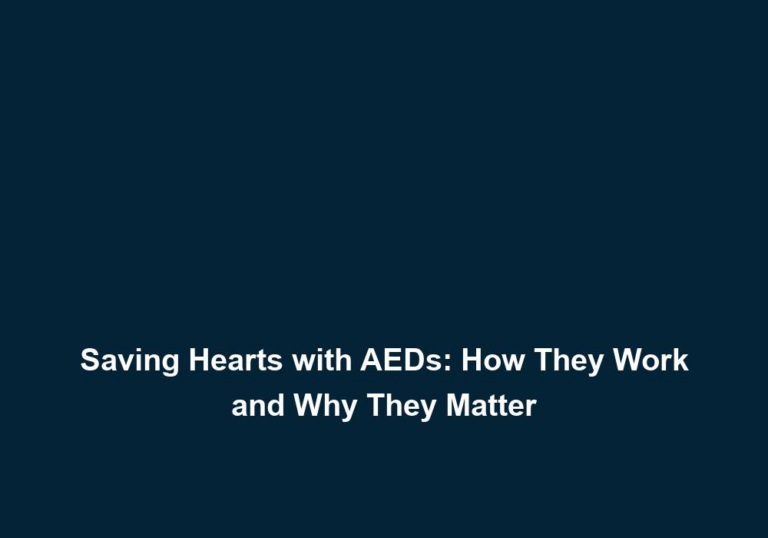Empowering You to Act: CPR Training That Makes a Difference
Cardiopulmonary Resuscitation (CPR) is a life-saving technique that can make a significant difference in critical situations. Being prepared and equipped with the necessary knowledge and skills can empower individuals to act swiftly and effectively in emergencies. This article will provide you with comprehensive information about CPR training, its importance, and how it can empower you to save lives.
What is CPR?
CPR, also known as Cardiopulmonary Resuscitation, is an emergency procedure performed on individuals experiencing cardiac arrest or sudden respiratory failure. It involves a combination of chest compressions and rescue breaths to maintain blood circulation and oxygen supply to vital organs until advanced medical help arrives.
CPR is crucial in restoring blood flow and oxygenation, significantly improving the chances of survival for the victim. By learning CPR, you can become a valuable link in the chain of survival, providing vital support to those in need.
The Importance of CPR Training
CPR training plays a crucial role in increasing the survival rates of cardiac arrest victims. Immediate initiation of CPR can double or even triple their chances of survival until professional help arrives. By receiving CPR training, you can become a valuable link in the chain of survival, providing vital support to those in need.
1. Confidence to Act
One of the primary benefits of CPR training is gaining the confidence to act in emergency situations. Often, people hesitate or feel unsure about how to respond when someone collapses or stops breathing. CPR training equips you with the necessary knowledge and skills to assess the situation, perform CPR correctly, and take control of the situation with confidence.
With CPR training, you will learn to recognize the signs of cardiac arrest and understand when and how to intervene. This knowledge empowers you to act promptly and confidently, increasing the chances of saving a life.
2. Life-Saving Skills
CPR training empowers you with the life-saving skills needed to perform CPR effectively. You will learn how to properly position your hands for chest compressions, deliver rescue breaths, and understand the correct rate and depth of compressions. These skills, when applied promptly, can restore blood flow and oxygenation, significantly improving the chances of survival for the victim.
During CPR training, you will also learn how to use automated external defibrillators (AEDs) effectively. AEDs are devices that deliver an electric shock to the heart to restore its normal rhythm. By learning how to use AEDs, you can further enhance your ability to save lives in emergency situations.
3. First Responder Role
CPR training also prepares you to take on the role of a first responder during emergencies. Being the first to respond to a cardiac arrest situation, your actions can make all the difference. By recognizing the signs of cardiac arrest and initiating CPR immediately, you can buy crucial time for the patient until professional medical help arrives.
As a first responder, you will learn how to assess the situation, call for help, perform CPR, and coordinate with emergency medical services. Your ability to act swiftly and efficiently can significantly impact the outcome for the victim.
4. Increased Awareness
Participating in CPR training increases your awareness of potential risks and emergency situations. You will learn to identify the warning signs of cardiac arrest and understand the steps required to provide immediate assistance. This heightened awareness can help you take preventive measures and contribute to a safer environment for yourself and those around you.
By understanding the causes and risk factors of cardiac arrest, you can make informed decisions to reduce the likelihood of such emergencies. CPR training also educates you about the importance of maintaining a healthy lifestyle, as certain lifestyle choices can increase the risk of cardiac arrest.
Effective CPR Training Programs
To ensure that you receive comprehensive CPR training, it is crucial to enroll in a reputable training program. Look for programs that are recognized by renowned organizations like the American Heart Association (AHA) or the Red Cross. These programs provide standardized training that adheres to the latest guidelines and best practices in CPR.
1. Hands-On Training
An effective CPR training program should offer hands-on practice to reinforce your skills. Practical sessions with manikins allow you to gain confidence in performing chest compressions, rescue breaths, and utilizing automated external defibrillators (AEDs). Hands-on training enables you to experience real-life scenarios and enhances your ability to respond appropriately during emergencies.
During hands-on training, you will have the opportunity to practice different CPR techniques and receive feedback from experienced instructors. This feedback helps you refine your skills and ensures that you are performing CPR correctly.
2. Experienced Instructors
The presence of experienced instructors is vital in an effective CPR training program. Instructors should possess the necessary expertise and certification to deliver high-quality training. Their ability to provide clear instructions, answer questions, and provide constructive feedback ensures that participants receive the best possible learning experience.
Experienced instructors can share real-life experiences and scenarios, enhancing your understanding of CPR and its application. They can also address any concerns or doubts you may have, ensuring that you feel confident in your ability to perform CPR.
3. Updated Curriculum
CPR guidelines and techniques are periodically updated to reflect the latest advancements in medical science. Therefore, it is crucial to choose a training program that incorporates the most recent guidelines. Updated curricula ensure that you receive training based on evidence-based practices, increasing the effectiveness of your CPR skills.
By choosing a training program that follows the latest guidelines, you can stay up to date with the best practices in CPR. This ensures that your CPR skills are aligned with the most current recommendations, maximizing the chances of successful resuscitation.
4. Certification
Obtaining a CPR certification is an essential outcome of completing a CPR training program. Certification serves as proof that you have completed the necessary training and possess the required skills to perform CPR. It can be beneficial in various personal and professional settings, such as healthcare professions, education, and volunteer organizations.
CPR certification demonstrates your commitment to saving lives and can enhance your employability in certain industries. It also provides reassurance to others that you have the knowledge and skills to respond effectively during emergencies.
Conclusion
CPR training is a valuable investment that empowers individuals to act promptly and confidently during critical situations. By learning CPR, you can become a vital link in the chain of survival, significantly increasing the chances of survival for cardiac arrest victims. Remember, being prepared and equipped with the necessary skills can make a remarkable difference in saving lives. Enroll in a reputable CPR training program today and empower yourself to act in emergencies.







